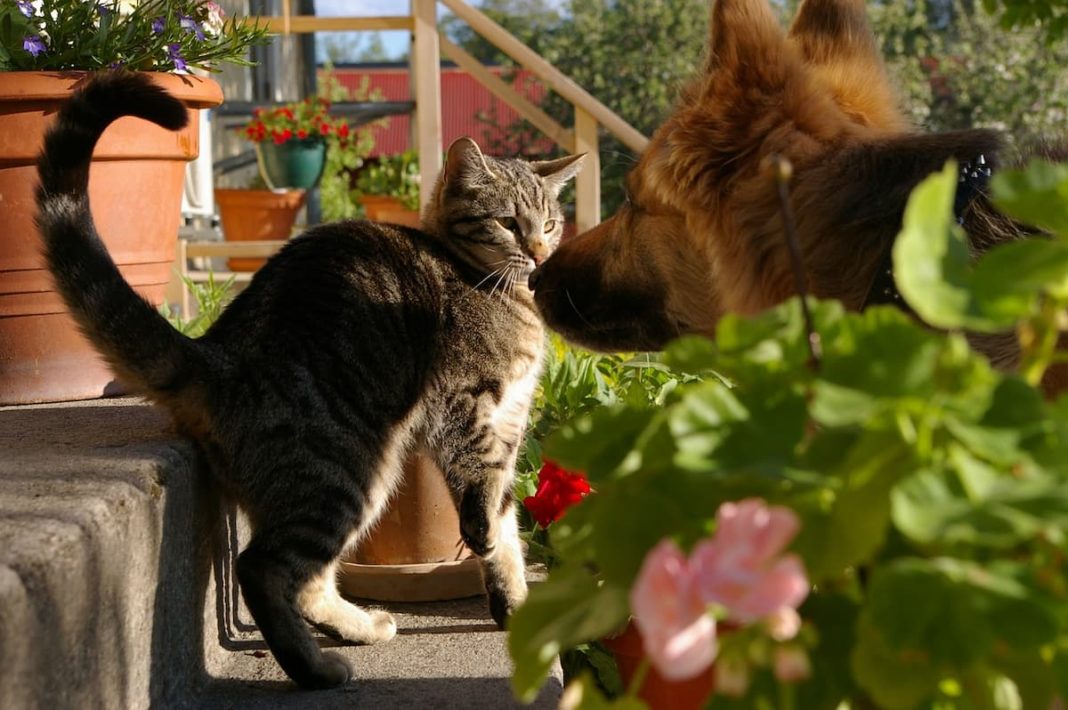Will My Cat Hate Me If I Get A Dog?
It’s possible for a cat to become a little jealous when their owner brings a new dog into the household. It’s not surprising given that cats are territorial and bringing a dog into the house can quickly make them feel jealous.
It can take a cat a few weeks to get used to the new dog and may act strange over the first few weeks. To ensure that your cat and dog get introduced and settle in together, here are tips on how to transition as quickly and stress-free as possible.
Although cats and dogs are sometimes thought of as enemies, with some careful planning, this doesn’t necessarily need to be the case. Although it’s true that some dogs are better suited to living with cats than others.
When bringing a dog home from a rescue centre, the staff will take your dog’s history and behaviour into account before deciding whether or not they could potentially live with a cat, and it’s also important to consider the dog’s different personality traits before bringing it into a household your cat. It’s important to be safe so that you can settle both pets up for success right from the start as first impressions will definitely count.
Preparation Before The New Dog Is Brought Home
In order to minimise the stress the new dog could have on your cat, you should try to keep them completely separate within your home for at least two weeks before beginning gradual introductions. The first few weeks allow the new dog to settle into their new environment and, essentially to calm down. This involves making sure that different areas within the house are only available to either the cat or dog during this time while they both adjust. Preparation around the house should start at least a week before the new dog comes home so that your cat is already used to their new routine.
Creating safe spaces for your cat away from the new dog’s designated area is important. The easiest way to do this is to split your home into two areas, a “cat zone” and a “dog zone”. You should already be mindful of where your cat currently spends most of its time already and try to establish this as the “cat zone”. If this isn’t possible, any changes to the cat’s areas should be made well before the new dog is brought home to allow your cat to adjust to their new set-up and routine. For flats/bungalows, a cat would ideally have its own room, but wherever they are, it’ll still need access to all their usual resources like food, water, a litter tray, their bed, toys and a scratching post.
One of your priorities is to make higher-up spaces like shelves/cabinets/tops of wardrobes available and safe for your cat as places they can retreat to or use as escape routes when things get too much.
Baby gates are perfect for sectioning off areas of the house, e.g. on the bottom of the stairs to prevent the dog from going into the cat’s safe space if it’s upstairs.
Make sure to add a second food and water bowl for your cat in a different area of the house (perhaps upstairs, if possible) and give them a temporary litter tray as well. Add an additional litter tray, even if they already have one in the home. Doing this takes the pressure off your cat to leave their safe space to go outside to go to the toilet before they are ready to properly meet the new dog.
If your cat has a preference for going to the toilet outdoors, try to ensure that they still have safe access to do so.
Pet plug-in diffusers give off synthetic pheromones for dogs and cats. These pheromones are designed to ease anxiety and may help your cat and the new dog feel more comfortable during the settling-in period. As the pheromones in these products release target different receptors in cats and dogs, they’re safe to be used together in the home. Make sure to set up your cat’s diffuser in an area where your cat will spend the majority of its time indoors; again, the same applies when adding the dog’s diffuser to the home.

Bringing Your New Dog Home
Before you leave to collect your new dog, make sure that your cat is safely in their safe space/room so that they’re on the other side of the front door when you arrive with the new dog! It’s very difficult for a relationship between a cat and a dog to recover if they’ve had a negative interaction straight away.
Once the new dog has arrived home, begin to swap blankets between your cat and the new dog regularly so they can get used to one another’s scent without adding any additional pressure on either pet. Although, this process can be started before bringing the new dog home, by seeing if you can place a blanket with your cat’s scent in the dog’s kennel or space and asking to take a blanket with your dog’s scent home for your cat.
On average, it takes 3 weeks for new dogs to destress and start settling into their new environment and routine, so don’t be tempted to rush introductions to the cat after the first few days.
Introducing Your New Dog To Your Cat
Once the new dog has had a chance to settle in for the first few weeks, you can start to gradually widen the cat and dog ‘zones’. This process needs to be done carefully over time, with the first few greetings being conducted with the dog on the lead, and ideally still behind a barrier like a baby gate. As dogs find chewing very relaxing, giving the dog a long-lasting chew can help keep it calm and occupied when your cat appears, which in turn could help your cat acclimatise to the dog better. While this will take time, it’s important to make sure that both the dog and cat are as calm and comfortable as possible at all times. Watch out for both of their reactions or have another person in the household help to make sure your cat is less stressed or anxious.
Step 1 – Set Up The Space
Before introducing the cat and dog, set things up so you are on one side of a barrier like a baby gate with your dog on the lead, with your cat on the other side. Make sure to have some of your dog’s favourite treats on hand to help them pay attention to you. Don’t force your cat into the situation, ideally, you should wait until they’ve chosen to rest somewhere that’s not their safe space, then calmly introduce the barrier, bringing the dog to them. It’s important to make sure that your cat has escape routes and is able to quickly and safely remove themselves from any situations they may find uncomfortable.
Step 2 – Keep Your Dog Calm And Reward Positive Behaviour
As soon as your dog sees your cat, calmly mark them looking at the cat with a “yes” or “good” (you need to stay consistent with your marker word), have your dog’s favourite treat in front of their nose and see if they’ll eat it. Look for their initial reaction; they may be calm, or they may be whining, stressed, excited, or barking. Look to see if your dog has abandoned their chew completely or gone back to it. When your dog seems alert and very interested in the cat, call their attention to you, leading them further away from the barrier and the cat to a distance where they’re able to better remain calm. Gently move them with the lead, if necessary, and then reward both with a treat.
You’ll want your dog to be looking at the cat very briefly before you mark the behaviour and then reward them for remaining calm. Only progress at your dog’s (and cat’s) pace, gradually building up the amount of time before calling your dog’s attention away and rewarding them for their calm behaviour.
Step 3 – Keep Your Dog’s Attention
If the dog gets too fixated on your cat and doesn’t look at you when called, try holding their favourite treat right under their nose, guiding their attention away from the cat. You’re your dog has switched their attention to you, reward the dog, move away to create a greater distance between the dog and the cat, and keep repeating the process.
As time goes on, you can wait quietly behind your dog to see if your dog will choose to look back towards you and away from the cat without you calling them. When your dog looks back on their own, start praising them heavily and reward them with a treat.
Step 4 – Remove The Lead While Keeping The Barrier
Once your dog is calm in this situation, and reliably able to look away from the cat and back towards you, try to get a hold of their attention again, this time without the lead, keeping the added security of the divider in place. Getting to this stage can take a few days, weeks or even months, depending on the dog. It’s vital for both of your pets that you don’t rush this.
Step 5 – Making Sure Your Dog Is Calm
It’s important to read the rest of your dog’s body language to determine if they’re truly calm. They may still be on high alert, but look happy when looking back at you for a treat. Until your dog is truly relaxed and calm in the presence of the cat that’s behind the baby gate, you should keep your dog on a lead. You can use a long line lead, as it’s a good middle ground between being on a fixed lead and being off lead completely, allowing you to retain physical control over your dog without needing to suddenly grab at their collar should they rush forward.
Step 6 – When To Remove The Divider
The divider should only be removed when the new dog is able to consistently remain calm when they’re off the lead and able to see the cat through, although you should still make sure your dog is put on a lead for the first true “face-to-face” meeting. Once the barrier has been moved, repeat the steps above, allowing the dog to observe the cat as you mark and reward them for staying calm. It’s normal for people to go backwards during this stage, so you may find you have to go backwards, with your dog to remain calm for short periods of time initially, but you can, slowly build up the amount of time they are able to remain calm as you’ve already done.
Again, it’s important that your cat has escape routes and is able to quickly and safely get away from any situations they may find uncomfortable.
If you’re still concerned about your dog’s behaviour around your cat after practising these steps for a few weeks, you may find it useful to get help from a qualified canine behaviourist. Often having a professional visit the home environment and witness the behaviour for themselves will allow them to identify areas where training can be tailored to your specific situation.
Conclusion
In short, cats see dogs as nothing more than furniture that barks, as dogs don’t really pose any territorial threat. Most cats peacefully coexist with household dogs as long as the dogs are not aggressive or too excited when around the cat.
Whether or not your cat will be jealous of the situation will depend on your cat’s personality, as each has its own distinct personality.









